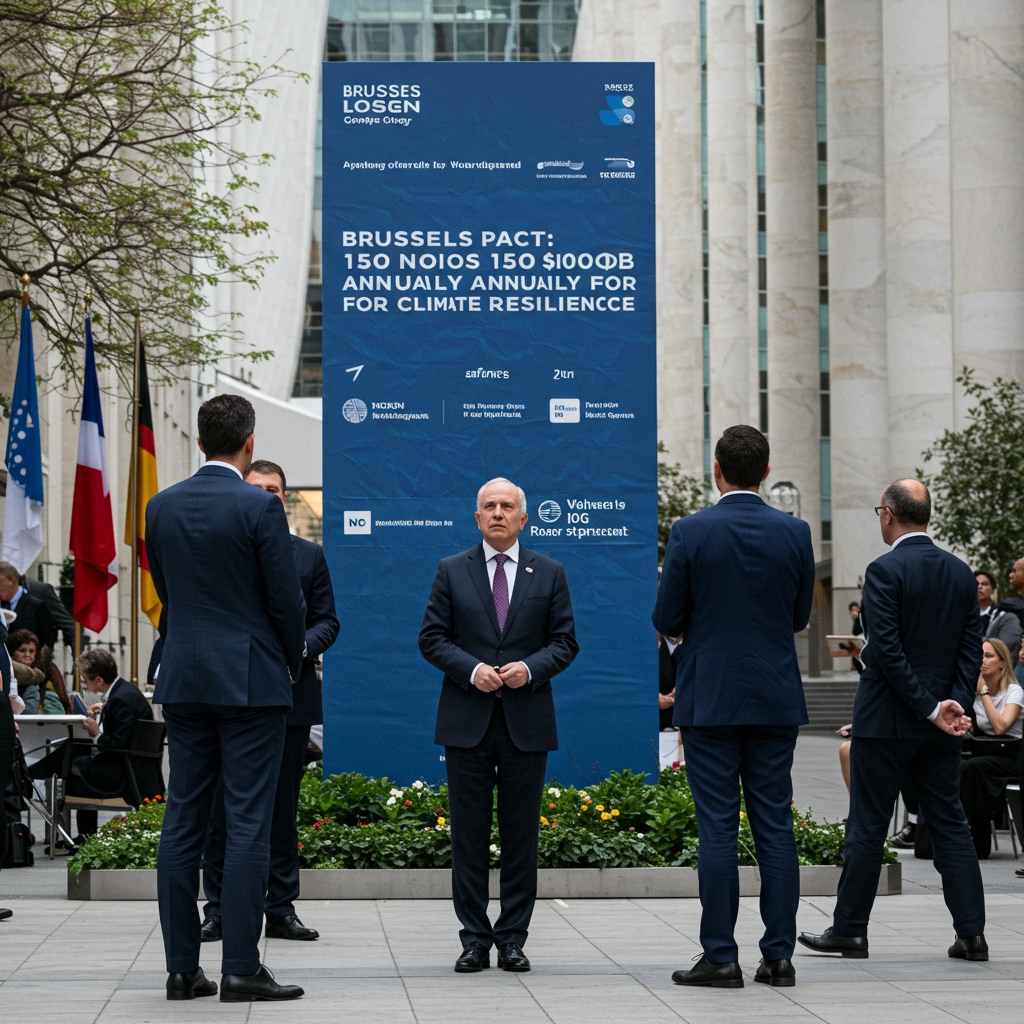Historic Climate Resilience Pact Finalized in Brussels
BRUSSELS – In a pivotal moment for global climate action, representatives from 150 nations today finalized the landmark “Brussels Climate Resilience Pact”. Signed following intensive negotiations, this ambitious agreement represents a unified international commitment to bolster defenses against the escalating impacts of climate change, particularly the increasing frequency and intensity of extreme weather events.
The pact brings together a diverse coalition of countries, crucially including major global emitters such as the United States, China, and the European Union. Their participation is seen as vital for the success and global reach of the agreement, signaling a shared responsibility to adapt to a changing climate alongside efforts to mitigate emissions.
The core financial commitment of the Brussels Climate Resilience Pact is substantial: signatory countries have pledged to invest a collective minimum of $100 billion annually specifically towards developing infrastructure and technologies resilient to climate-intensified extreme weather. This funding is slated to begin in 2026, marking a dedicated and recurring global investment stream for adaptation efforts.
Sources close to the negotiations indicated that reaching consensus on the funding mechanism and distribution was a complex process, requiring compromises from many sides. The final figure of $100 billion annually reflects a shared understanding of the massive scale of investment needed to protect communities and economies from threats like severe floods, prolonged droughts, devastating heatwaves, and other climate-related disasters.
Key Initiatives Driving Global Adaptation
The Brussels Climate Resilience Pact outlines several key initiatives designed to translate the financial commitment into tangible action and build a globally coordinated approach to climate adaptation. These initiatives address critical areas of vulnerability and aim to leverage international cooperation and scientific advancements.
One central initiative is the establishment of a global early warning system. This system is envisioned to provide timely and accurate alerts for specific extreme weather phenomena, including floods and heatwaves. By improving the ability to predict and warn populations about impending dangers, this system aims to minimize loss of life and reduce economic damage. Experts believe a unified global approach is essential, particularly for transboundary hazards and ensuring that vulnerable populations in data-poor regions also benefit from advanced warning capabilities.
Another significant component of the pact is the creation of the Global Adaptation Fund (GAF). This new fund will be headquartered in Nairobi, Kenya, underscoring the importance of African leadership and the particular vulnerabilities faced by many African nations to climate impacts, especially in agriculture. The GAF is specifically earmarked to fund drought-resistant crop research. As global temperatures rise and precipitation patterns shift, ensuring food security through the development and dissemination of resilient agricultural practices and crop varieties is paramount. The location in Nairobi is seen as strategic, placing the fund’s operations close to regions heavily impacted by drought and food insecurity.
A third key initiative focuses on building a common understanding of climate risks through the implementation of standardized vulnerability assessments. The pact commits countries to conducting these assessments across critical sectors – likely including infrastructure, water resources, agriculture, and public health – by 2030. Standardizing methodologies will allow for better comparison of risks across regions, facilitate the identification of global hotspots, and provide a data-driven basis for directing resilience investments under the pact. This initiative is crucial for ensuring that the $100 billion annual investment is allocated effectively to areas where it can have the greatest impact.
Implementation and Future Outlook
The signing of the Brussels Climate Resilience Pact is widely hailed as a critical step, but significant work lies ahead. The operationalization of the Global Adaptation Fund (GAF), the technical development and deployment of the global early warning system, and the rollout of standardized vulnerability assessments by 2030 will require sustained effort and international cooperation.
Mechanisms for tracking and verifying the $100 billion annual investment starting in 2026 will also be crucial to ensure accountability and transparency. While the pact sets the financial floor, the actual needs for climate adaptation globally are estimated to be significantly higher, suggesting that this agreement is a foundational step rather than a complete solution.
Environmental groups present in Brussels welcomed the agreement but stressed the importance of rapid implementation and ensuring that the funds reach the most vulnerable communities. Industry representatives noted the opportunities the pact presents for innovation in resilient technologies and infrastructure development.
The Brussels Climate Resilience Pact, signed by 150 nations including the United States, China, and the European Union, establishes a dedicated financial commitment of $100 billion annually from 2026 for adaptation, initiates a global early warning system for floods and heatwaves, creates the Global Adaptation Fund (GAF) in Nairobi, Kenya, to fund drought-resistant crop research, and mandates standardized vulnerability assessments across critical sectors by 2030. It marks a significant collective acknowledgment of the urgent need to build resilience in the face of a changing climate and lays the groundwork for future international collaboration on adaptation.





